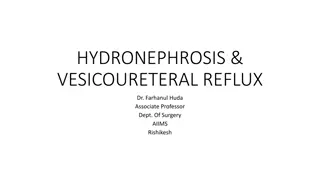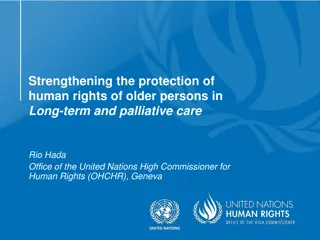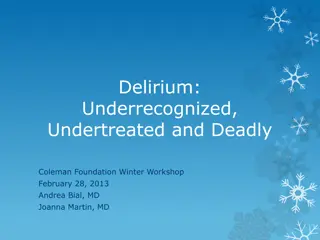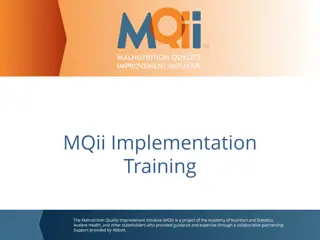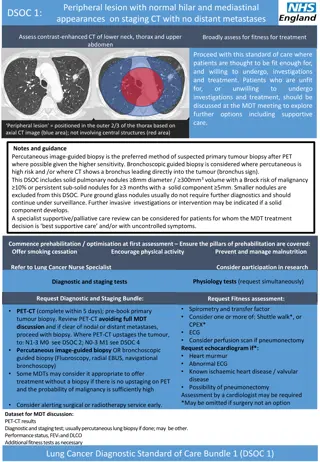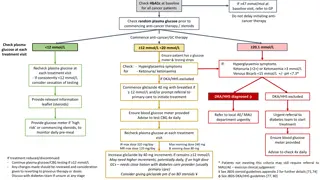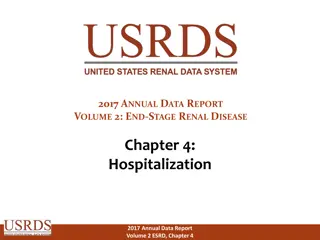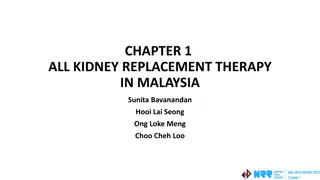Management of Hydronephrosis in Palliative Care Patients: Guidelines and Considerations
Malignant ureteric obstruction in palliative care patients poses significant challenges, impacting quality of life and requiring long-term drainage. This article discusses factors influencing decision-making, treatment options, and follow-up considerations, highlighting the importance of a multidisciplinary approach involving urologists, oncologists, and palliative care teams. Various guidelines and therapeutic goals for urinary drainage are also outlined, emphasizing the need for a personalized approach considering quality of life implications.
- Palliative Care
- Hydronephrosis Management
- Urology Guidelines
- Multidisciplinary Approach
- Urinary Drainage
Download Presentation

Please find below an Image/Link to download the presentation.
The content on the website is provided AS IS for your information and personal use only. It may not be sold, licensed, or shared on other websites without obtaining consent from the author. Download presentation by click this link. If you encounter any issues during the download, it is possible that the publisher has removed the file from their server.
E N D
Presentation Transcript
HYDRONEPHROSIS IN PALLIATIVE CARE PATIENTS MARIUS CRACIUN ST7 UROLOGY, HENW DEANERY
OBJECTIVES Background Guidelines Options for decompression Factors to help in decision making Regional practice
POINTS TO COVER Which patients should be referred to urology Management options (and how the decision is reached from a urologist's point of view) Complications of ureteric stents and nephrostomies; follow up considerations
BACKGROUND Malignant ureteric obstruction is a condition that affects patients with advanced stages of cancer. An obstructed single system can significantly reduce patients quality of life especially if infection ensues; however, bilateral obstruction will lead to a certain death. Often, when the malignant process affects the ureter, the resulting obstruction is very difficult to cure and can potentially require long-term decompression by drainage or diversion. Ureteral stent insertion in the management of malignant ureteric obstruction can be linked to a high failure rate
BACKGROUND Upper urinary tract obstruction is a prognostic indicator of morbidity for many cancers. Currently prostate and bladder cancer account for most urological malignancies. Change from single discipline decision to multidisciplinary approach involving urologists, oncologists, palliative care team, general medicine and interventional radiologists.
THERAPEUTIC GOALS OF URINARY DRAINAGE Adequately drain the upper urinary tracts for symptomatic relief. Maintain renal function, allowing the initiation of systemic therapy. Minimising further intervention, hospitalisation and negative QoL
GUIDELINES EAU, AUA and NICE - recommend decompressing the urinary systems, but there is a lack of consensus as well as strong evidence to support the decision process NICE - patients should be offered decompression, but that the option of no intervention should also be discussed . None of these recommendations take into consideration the implications of quality of life
GUIDELINES EAU: it is good practice to drain symptomatic hydronephrosis and to drain only one kidney (the less dilated and better appearing kidney or the one with the better function, if known) in asymptomatic patients EAU: PCN is superior to a stent for drainage for pelvic malignancies but advocate either stenting or nephrostomies in other tumour groups, But neither of these recommendations reference the literature nor do they mention implications of quality of life.
NEPHROSTOMY Pros More likely to improve and preserve renal function than stents (? better for younger patient requiring aggressive chemotherapy to improve survival) Can be done under LA Cons Prone to blockages and can dislodge and needs reinsertion Dressing care, can leak, source of infection (some oncologists don t like them) Ideally exchange every 3 months Risks Bleeding, bowel injury, failure
URETERIC STENT Pros No external tubes / drains Cons Needs GA (most of the cases) Needs exchange every 6-12 months Stent related symptoms Can get encrusted / blocked Not very effective in extrinsic compression Risks GA risks Failure to insert
PERCUTANEOUS NEPHROSTOMY OR STENT? For benign disease (stone) 3 trials no difference For malignant disease - not clear / not much data PCN insertion has higher success rate compared to retrograde stenting in malignant ureteric obstructions, especially when urgent decompression is necessary
METALLIC STENTS Theoretical advantages of metal stents over polymer ones include reduced encrustation, improved tensile strength and stability, prolonged stent indwell time, and better flow Despite the initial enthusiasm about metallic stents in the management of malignant ureteric obstruction, such stents are reported to have a failure rate of 38-48% in malignant cases Liatsikos EN, Karnabatidis D, Katsanos K, Kallidonis P, Katsakiori P, Kagadis GC, et al. Ureteral metal stents: 10-year experience with malignant ureteral obstruction treatment.J Urol 2009;182:2613-7.
EXTRA- ANATOMICAL STENTS Formation of an alternative passage for urinary drainage from the renal pelvis to the bladder using a tunnelled subcutaneous system, bypassing the ureter
FACTORS TO HELP IN DECISION MAKING Prognosis Quality of life associated with the PCN or stent Major and minor complications Morbidity defined as hospitalisation post intervention Further treatment
PROGNOSIS 50 papers included prognosis as an outcome measure with n=2790 patients 21 h to 140 months with a median survival of 6.4 months The mean of the percentage of patients surviving one year was 23% Patients with a malignancy of unknown primary or gastrointestinal origin were identified as having poorer outcomes, whereas gynaecological malignancies had a better outcome. Low albumin / no further treatment options / number of malignant related events (effusion, metastatic disease, ascites etc), PS 2 or more, low Na
QUALITY OF LIFE Can be challenging to measure (how much is caused by obstruction and PCN or stent or other cancer features) 5 studies that used Grabstald outcome measure tool, n=167: 60% of patients were able to achieve a useful life post decompression 4 studies no difference in QoL between PCN and stent
COMPLICATIONS Overall complication rate 41 % 26% PCN vs 14% stent had urinary infection (?urosepsis) 10% dislodged PCN, 7% blocked PCN 6% had stent migration Haematuria 8% stent vs 3% PCN 0.2% had nephrectomy post PCN 0.2% mortality post PCN (other papers 5%)
MORBIDITY DEFINED AS HOSPITALISATION POST INTERVENTION 12 paper: 26% (range 5%-69%) - patients never left hospital post decompression Also patients spent 20% of their remaining lifetime in hospital. Effect on renal function: creat improved from 624 to 212
REGIONAL EXPERIENCE / PRACTICE Data from M Abdulmajed, C Seipp, I Shergill North Wales 3 hospitals Jan 2012 Feb 2016 70% of PCN were for malignancy (prostate and bladder most common cancers) Immediate or late complications (median 14 days) PCN failure in 8.4% Stent failure (antegrade) - (median 40 days) 17.7% Mortality at 3 months 53% with no noticeable impact of age, performance status or change in renal function variables on survival
CONCLUSION Multidisciplinary approach Patients should be: centrally involved in discussion and decision making. fully aware of their disease stage and prognosis before making decision. made aware of the facts and risks associated with renal decompression.
Ku JH, Lee SW, Jeon HG, Kim HH, Oh SJ. Percutaneous nephrostomy versus indwelling ureteral stents in the management of extrinsic ureteral obstruc- tion in advanced malignancies: are there differences? Urology 2004;64: 895-9. Feng MI, Bellman GC, Shapiro CE. Management of ureteral obstruction secondary to pelvic malignancies. J Endourol 1999; 13: 521-524. Hyppolite JC, Daniels ID, Friedman EA. Obstructive uropathy in gynecologic malignancy. Detrimental effect of intraureteral stent placement and value of percutaneous nephrostomy. ASAIO J 1995;41:318-23. Chang HC, Tang SH, Chuang FP, Wu ST, Sun GH, Yu DS, Chang SY, Cha TL. Comparison between the use of percutaneous nephrostomy and internal ureteral stenting in the management of long-term ureteral obstructions. Urol Sciences 2012;23:82-4.


